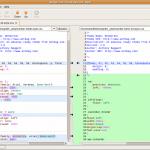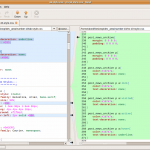More on Number 10’s website fiasco
Being “that-kind-of-a-bloke”, I thought I’d dig a bit further into the Number 10 Steals Free WordPress Theme story 😉
Here’s the background:
- No. 10 Are running WordPress1
- The theme (or template) is based on one called NetWorker2
- The attribution and copyright notice that is in the original footer has been removed
- The site claims to be Crown Copyright and makes no reference to the CC-by-sa license used in the original template
I am a bit confused here. Why would a web design shop (or “Full Service New Media Agency” as they call themselves), who were apparently paid the best part of £100k for this job3, use somebody else’s template as the basis for their design?
- You might think it would be because using a pre-made template would save you loads of tricky coding and playing around with CSS trying to get your site to look the same in IE6, IE7, Firefox, Safari and Opera [A task I am quite familiar with myself].
- You might also think that using a pre-made template would allow you to make minor modifications, add some different images and give you something that looks really different.
- Of course it might be simply that you don’t have time to create a new theme from scratch and using an “off-the-shelf” template will mean you can get the site up and running much faster.
- Or another possibility could be that you like ripping off your customers for as much as possible and using a free (or even a bought) template will mean your costs are minimal.
All, some, or none of the above could be reasons to use an existing template as a basis for your new design.
So how much new coding would be needed making the changes to an existing template to suit your new design? 10%, 20%, maybe even 50% and it would still be worth while…
Get this: the revised stylesheet from Anthony Baggett’s template is more than 6 times the original’s length and size! And that isn’t all made up of whitespace either…
The original stylesheet4 is 612 lines in length and is 9234 bytes in size (9KB).
The modified stylesheet5 is 3826 lines long and weighs in at a frankly astonishing 63724 bytes (63KB)!
You can obviously download the two stylesheets from their websites directly (I recommend using a plugin for Firefox called Web Developer) or to make things easier, I have made them available at the bottom of this page.
Looking through the new file, the amount of duplication and repetition of styling of the same, or very similar elements, is quite odd. It certainly isn’t the way I would construct a theme. Why duplicate the same styling over, and over, and over again when you could craft the logic so that each of these elements have a commonality that could then be controlled with a much smaller stylesheet?
Here are a few screenshots showing some of the differences between the two files. In the brilliant Open Source comparison application Meld I’m using here, the original stylesheet is shown in the left pane and the modified one is on the right. The first image shows the very top of both files with Anthony’s header still in tact. The second and third are just a couple of fairly random points where the new file contains a great deal of repetition as I am walking down through the files. The final image shows the bottom of both files (note the line numbers!).




One thing that is clear from using a tool like Meld is that these two files are definitely related. The way the application displays the differences, it is clear where the files are the same and where they differ. The larger file is certainly a derivative work of Anthony’s original.
Another aspect I found rather funny in this investigation was the method of version control for this huge stylesheet. Both stylesheets have the same version number and there doesn’t appear to have been any tool used to update the header as would be usual. How on earth does a business that develops a ~4000 line stylesheet manage to do that without using some sort of versioning system?
I have helped businesses use and modify pre-made templates for Joomla!, and to be honest if you are making changes of any significance to these templates, it is almost always easier and quicker and cheaper to start from scratch. For small mods and changes pre-bought templates can be really good value (I mean $50 is fairly average), but getting your head around someone else’s code is never easy and takes considerable time. For major alterations it just doesn’t make financial sense.
Now, making additions and changes just to the stylesheet of more than 6 times the original is not good business sense in my opinion. How much more work have they done to the PHP code that we can’t see? We know they have modified at least index.php (by removing the WordPress statistic generator meta tag) and footer.php (by removing Anthony’s copyright notice). But if they have made SO MANY changes and additions to the stylesheet, there surely must be a good deal of altered php code, or additions, in the core php files too? Surely, it would have been easier to make a new template from scratch in this instance?
This leads on to the other question that might be worth digging into a bit more; GPL violations:
“If” the developers have modified the WordPress engine, as is being suggested as a possibility here, and then sold it to the Government, in my humble understanding that means they have distributed their modifications. That means those modifications must also be licensed under the GPL. I had a quick look on New Media Maze’s web site and couldn’t find an area for software downloads or mention of the GPL. That doesn’t say anything to be honest and there might be nothing to this, but it would be interesting to find out a bit more… Is there a real WordPress guru who can look at the “footprint” of the XHTML the site generates and tell if it is different? Or are there any other ways to tell if it has been modified?
Anyway, what a wheez this all is for us bloggers: It just isn’t Gordon’s year is it…
1. www.number10.gov.uk/
2. NetWorker Theme
3. £100k for WordPress site
4. Anthony’s original stylesheet
5. No. 10’s heavily modified stylesheet
Tags: #10, Government, GPL, Joomla!, Meld, Web Developer, Wordpress



My understanding of the GPL may well be incorrect but all the wordpress modifyers have to do is make the changes available to their customer (ie the government.) Presumably they have done so because they are running it. 🙂 As far as I am aware they are not obliged to make the changes publicly available to everyone.
@Jack,
That sounds about right, according to this bit of the FAQ, http://www.gnu.org/licenses/gpl-faq.html#GPLRequireSourcePostedPublic, at least:
“Does the GPL require that source code of modified versions be posted to the public?
… But if you release the modified version to the public in some way, the GPL requires you to make the modified source code available to the program’s users, under the GPL.”
This bit however, http://www.gnu.org/licenses/gpl-faq.html#TheGPLSaysModifiedVersions, says something different and is more in line with my humble understanding:
“GPLv2 says that modified versions, if released, must be “licensed … to all third parties.†Who are these third parties?
Section 2 says that modified versions you distribute must be licensed to all third parties under the GPL. “All third parties†means absolutely everyone—but this does not require you to *do* anything physically for them. It only means they have a license from you, under the GPL, for your version.”
@Alan – Yes, I agree. Presumably the second clause above is to cover the case if your customer decides to make available your modifications public that you the licensee won’t have a problem with third parties using your modifications. So far as I am aware that doesn’t obligate either the customer or the licensee to make those modifications public. Of course the customer can make the changes public any way they like. Usual disclaimers apply…I ain’t a lawyer…
@Jack,
“I ain’t a lawyer…”. Me neither – thankfully 😉
Isn’t the whole idea of the GPL and copyleft that it is “viral”? So, IIUC, as the WordPress code is distributed and available freely to anyone, modifications made to it (if the modifier distributes them to anyone) must be also?
I was pondering also just how “public” is a Government owned web site… After all, where did the money come from in the first place?
Interesting… Thanks for questioning Jack.
@Alan – I think there is a difference between what is a legal requirement via the GPL licence and what is “best” practice. I don’t believe that you are required under the GPL to release your changes publicly…you are only required under the licence to release the changes to your customer. Your customer may release them publicly if they wish…
As for the government angle, I believe they should be obliged to make just about everything public but that’s just my political views getting in there…
@Jack,
well put.
As for the Government angle, I totally agree. In fact on the GPL FAQ again, http://www.gnu.org/licenses/gpl-faq.html#GPLUSGovAdd, in the USA at least, they seem to have a reasonably clear position on all works created being in the public domain:
“If the program is written by US federal government employees in the course of their employment, it is in the public domain, which means it is not copyrighted. Since the GNU GPL is based on copyright, such a program cannot be released under the GNU GPL. (It can still be free software, however; a public domain program is free.)
Shame we aren’t so transparent…
[…] As if Mr Brown didn’t have enough to deal with at the moment it appears that the shiny new website he paid £100,000 for might have been based on a free WordPress theme. […]
I’ve written up the facts around the copyright issue here if you’re interested: http://www.newmediamaze.com/index.php/antbags-theme-the-facts/
@Dave,
Thanks for the link. I had just started reading it.
[…] story so far, for any new readers. can be found here, here and here and do follow the links in those posts to the various other sources to get a broader […]